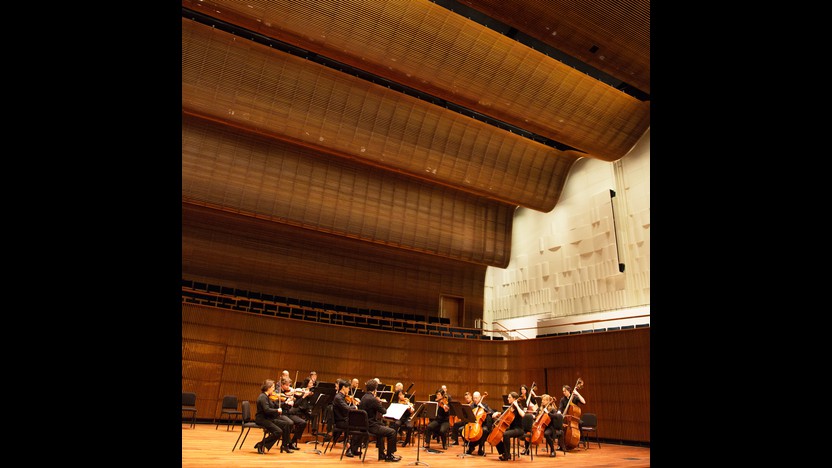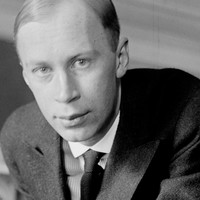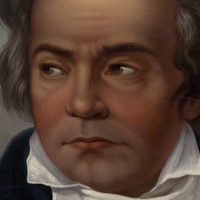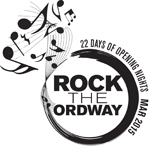Special Performances: New Ordway Concert Hall Opening Celebration

Sponsored By
- March 5, 2015

- March 6, 2015


Sponsored By


 Listen to Audio
Listen to Audio
Spending the summer outside of Petrograd in 1917, the 26-year-old Sergei Prokofiev challenged himself to compose without sitting at the piano, and he used Franz Joseph Haydn as inspiration for his svelte First Symphony. This score’s nickname as the “Classical” Symphony is well-deserved, and it served as an early harbinger of the neoclassical trend that swept through modern music in the 1920s.
A leading orchestra in Haydn’s day operated out of the royal court in Mannheim, Germany, and one of their signature moves was the rising “Mannheim Rocket,” which Prokofiev mimicked with the explosive arpeggio that launches his symphony. The second theme, played by the violins as they navigate absurdly wide leaps, shows how effectively Prokofiev used parody and exaggeration to simultaneously celebrate and skewer his source material.
The Larghetto second movement centers on a singing theme that enters in the clear treble of the violins. A contrasting middle section introduces a steady trickle of sixteenth notes, and then the closing passage interweaves both sounds.
Instead of a minuet or scherzo, the symphony turns next to a Gavotte, a staple of French dance suites from the Baroque era. The finale races to the finish on a stream of whirlwind eighth notes, with interlocking rhythmic patterns and seamless handoffs between sections that make for the musical equivalent of a relay race.
Aaron Grad ©2024

The composer has provided the following program note:
Coraggio for String Orchestra is a nine-minute work based on the first movement of my String Quartet #3, which is subtitled “Coraggio.” I have altered several sections of the work for the new idiom and have integrated a double bass part where appropriate. A version for full strings was premiered in Athens by the Athens Camerata in 2007, and this new arrangement was commissioned in 2014 by the SPCO specifically for the opening of their new Concert Hall at the Ordway.
An insight relating to the evocative title is offered in the liner notes, written by the late American composer George Rochberg, to the American String Quartet recording (on New World Records) of my Third and Fourth string quartets:
“In the program note to his Third String Quartet,” Rochberg wrote, “George Tsontakis acknowledges the great contrasts between his Second Quartet (composed for the Emerson Quartet in 1983) and the Third, which followed two years later. While the Second is a ‘severely introverted and intense semitonal work, submerged in the seemingly inescapable malaise of our time,’ the Third, which he calls “Coraggio” (courage), ‘offers a certain exuberance and brightness, an optimism that might be based on our blindness –a—momentary lapse into forgetfulness—to what surrounds us, or else perhaps on the tenacious human spirit we have inherited, where even in the worst of times there is a taking of heart and welling up of courage.’
Rochberg continued: “I don’t think it is too farfetched to suggest that in composing his Third Quartet Tsontakis was stating, in purely musical terms, a credo which arose from a hard-won conviction that modernism and modernity had to be broken with—set aside by an act of will. He acknowledges freely his ‘reliance on the stability of diatonically triadic harmonies’ and his debt, ‘gesturally...to the work of the late classical masters.’ The great physical energy of [this work] is an important part of, and is intensely related to, Tsontakis’s gifts as a composer; he has the ‘luck’ of having concrete musical ideas that the ear can perceive and the mind hold in memory—expressed in concentrated, densely packed, nodule-like motives that the composer treats obsessively, and which, as they spread out in time and spin in tight figurational, centripetal orbits, create structure and gesture.”
George Tsontakis ©2014

After writing a monumental symphony that dwarfed his two previous efforts (and those of all composers who came before him), Ludwig van Beethoven gave the Symphony No. 3 in E-flat Major the subtitle of "Bonaparte," honoring the military mastermind of Revolutionary France. But the composer’s adulation turned to disgust in 1804, when he learned that Napoleon had crowned himself Emperor; according to the student who delivered the disturbing news, Ferdinand Ries, “Beethoven went to the table, seized the top of the title-page, tore it in half and threw it on the floor.” When preparing the symphony for publication in 1806, Beethoven re-titled it "Sinfonia eroica, composed to celebrate the memory of a great man,” without specifying who that other hero was.
The defining motive of the Eroica Symphony’s first movement is a rocking cello strain that trails into foreign harmonies after four measures. As the central development section closes, a French horn makes a surprise entrance with a recapitulation of that same theme a few measures ahead of schedule — an effect so unexpected that even Beethoven’s student Ries, upon hearing the symphony for the first time, suspected the horn player of having lost count of the measures.
The symphony’s second movement, labeled a funeral march, sinks into a prolonged state of despair that might induce misery if not for its undeniable grace and beauty. A major-key interlude, providing respite, incorporates an arpeggiated accompaniment that recalls the gentle sway of the first movement. After returning to the minor key, the appearance of fugal counterpoint reinforces the profound, ceremonial atmosphere of the funeral march.
Out of this grief comes a giddy Scherzo, a symphonic construct that Beethoven popularized as an alternative to Franz Joseph Haydn’s slower, tamer minuets. A contrasting trio section features the three horns in vigorous hunting calls.
The finale, built as a theme and variations, incorporates material from the ballet The Creatures of Prometheus that Beethoven had also used in an earlier set of piano variations. A short but fiery introduction gives way to an unusual presentation of the theme, reduced to its bare skeleton.
Aaron Grad ©2024
Please note: These concerts are currently SOLD OUT. If you would like to attend one of these performances, please select one of the waiting lists below and we will contact those on the waiting list should additional tickets become available.
Waiting list for Thursday, March 5
Waiting list for Friday, March 6
Join us one hour before any of these special performances to hear SPCO President and Managing Director Bruce Coppock and Concert Hall Acoustician Paul Scarbrough discuss the design of the hall and the acoustical tuning process.
Join us for these historic concerts and you’ll also enjoy free champagne and live jazz after the performances.
Have questions about the new Ordway Concert Hall? Visit thespco.org/concerthall for information about our new downtown Saint Paul home.

ROCK THE ORDWAY this March with an unprecedented mix of eclectic artists and performances specifically chosen to shake things up while also showcasing the state-of-the-art acoustics and intimacy of the new Concert Hall. Whether you’re into classical, R&B, opera, show tunes, Latin-fusion, love songs, the sounds of South Africa or choral music, please help us open the doors, raise the roof and celebrate Minnesota’s newest world-class performance hall. Learn more at ordway.org/rocktheordway
Get driving directions and find nearby parking.
Find dining options close to the venue.
View seating charts to find out where you'll be seating.
SPCO concerts are made possible by audience contributions.
For exclusive discounts, behind-the-scenes info, and more:
Sign up for our email club!
